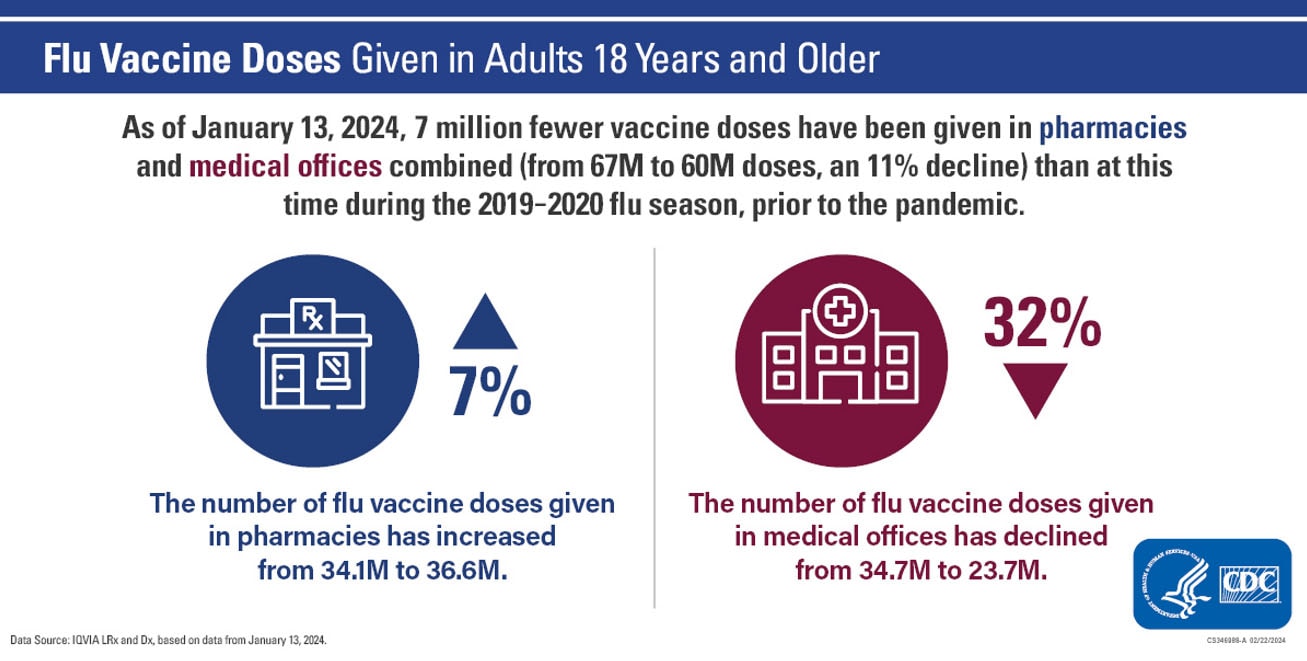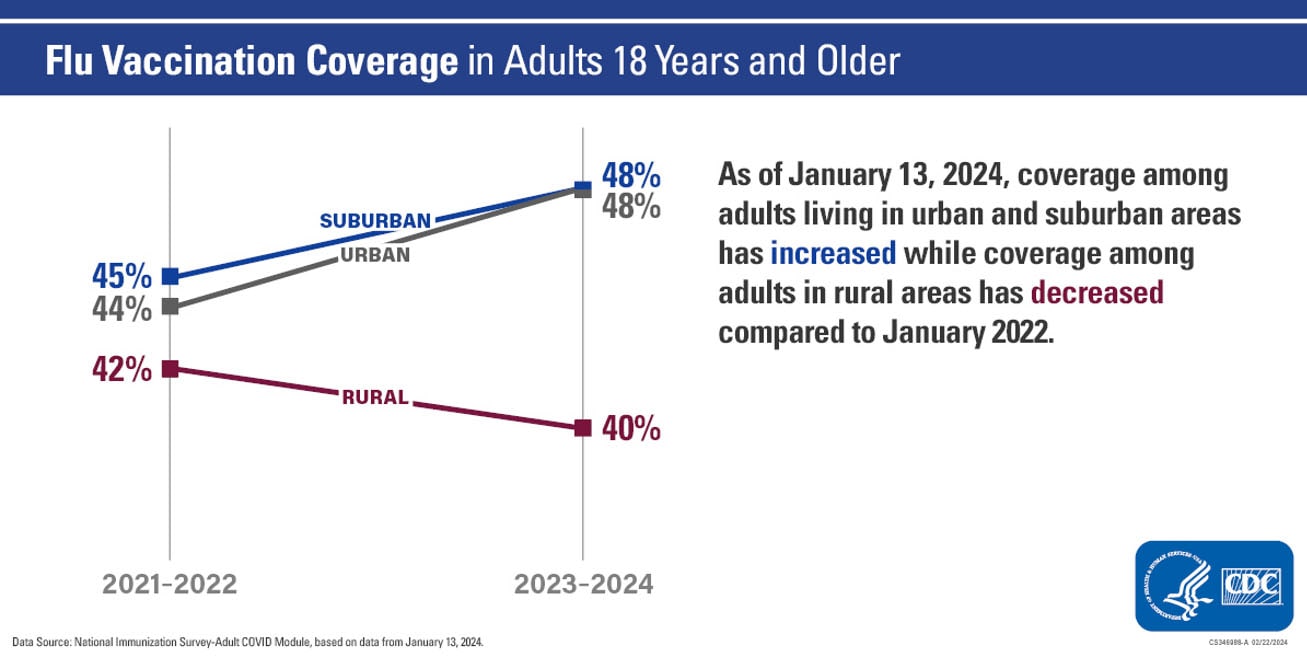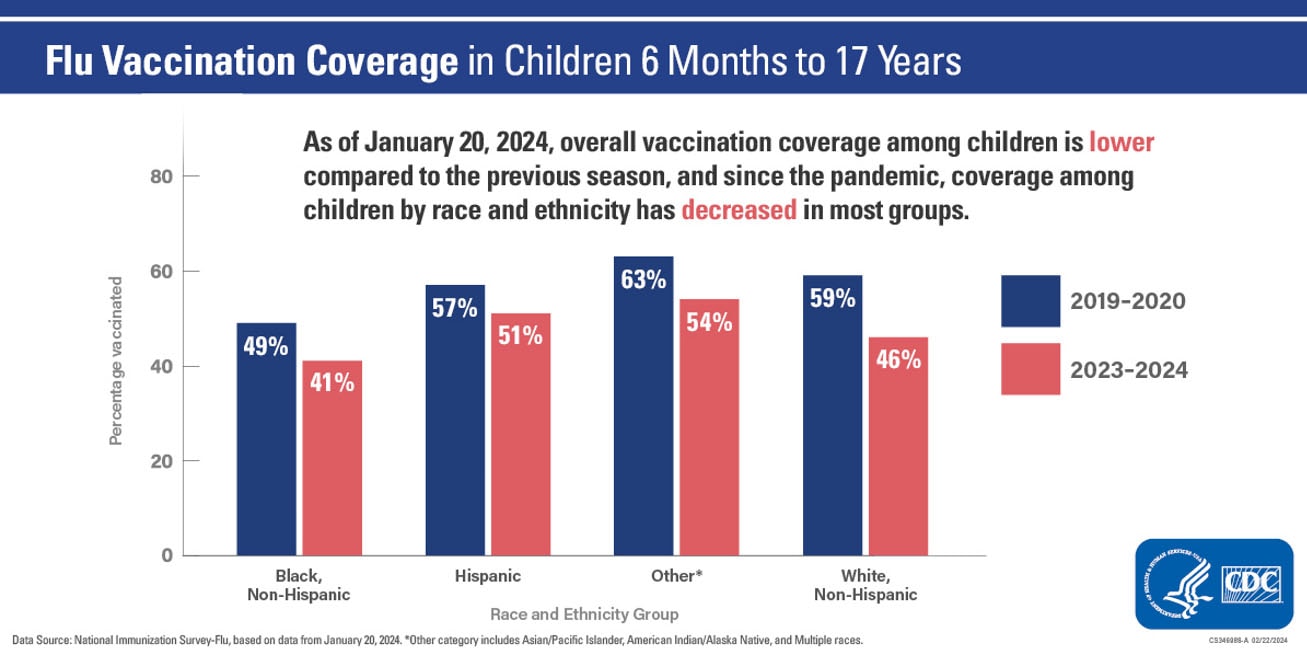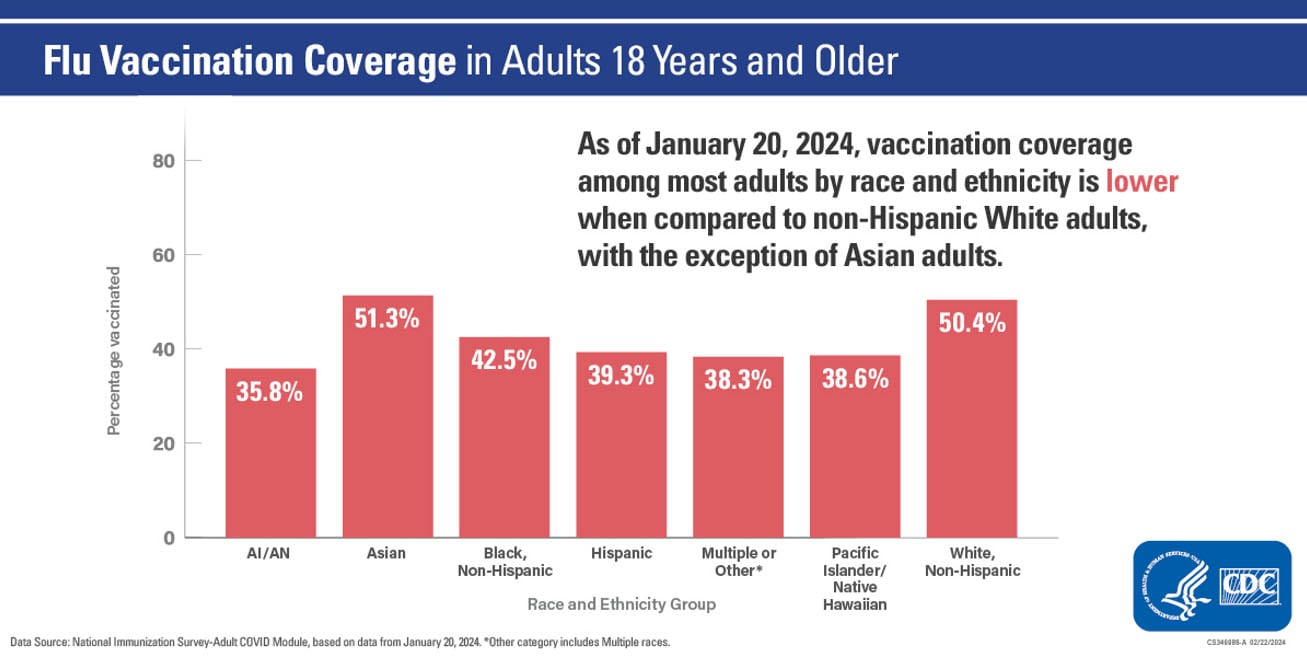2023-2024 Flu Vaccine Coverage Update (Continued)
February 2, 2024—This update compares flu vaccination coverage across several indicators to the same time last season as well as prior to the COVID-19 pandemic when available.
Doses Given in Pharmacies and Medical Offices
According to insurance claims data for adults 18 years and older, as of January 13, 2024, the number of flu vaccination doses given so far this season in pharmacies and medical offices is lower compared with last season by about 7 million doses (from 67 million to 60 million doses, or about an 11 percent decline). There were drops in the number of doses given in both pharmacies and medical offices this season compared with last season.
- Vaccinations at pharmacies declined by about 4 million doses compared to last season (from 40 million to 36 million doses, or about a 10 percent decline)
- Vaccinations in provider offices declined by about 3 million doses (from 26 million to 23 million doses, or about a 12 percent decline).
Since the COVID-19 pandemic, there has been an overall increase in the numbers of doses of flu vaccine given in pharmacies, while there has been an overall decrease in the number of flu vaccine doses given in provider offices.
- Flu vaccinations given in pharmacies increased by 2.5 million doses from 2019-2020 to 2023-2024 (from 34.1 million to 36.6 million doses, or about a 7 percent increase).
- Flu vaccinations given in medical offices decreased by 11 million doses since 2019-2020 (from 34.7 million to 23.7 million doses, or about a 32 percent decline).

More information is available from FluVaxView’s Weekly Flu Vaccination Dashboard (Figure 7, when sorted by place of vaccination).
Rural Versus Urban/Suburban Vaccination Coverage
Disparities in vaccine uptake are sustained or worsening among people living in rural areas compared with those living in suburban or urban areas.
For children, as of January 20, 2024, flu vaccine coverage among children residing in rural areas was about 17 percentage points lower compared with children living in urban areas (36% compared with 52%) and about 12 percentage points lower compared with children living in suburban areas (36% compared with 48%).
Compared with the same time last season, coverage among children living in rural, suburban or urban areas has changed as follows:
- coverage among children residing in rural areas is 4 percentage points lower so far this season compared with last season (36% compared with 40%).
- coverage among children residing in suburban areas is 4 percentage points lower so far this season compared with last season (48% compared with 52%).
- coverage among children residing in urban areas is similar so far this season compared with last season (53% compared with 54%).
Since the COVID-19 pandemic, coverage by urbanicity among children has declined as follows:
- coverage among children residing in rural areas is 16 percentage points lower so far this season compared with 2019 (36% compared with 52%).
- coverage among children residing in suburban areas is 10 percentage points lower so far this season compared with 2019 (48% compared with 58%)
- coverage among children residing in urban areas is 6 percentage points lower so far this season compared with 2019 (53% compared with 59%).

More information is available from FluVaxView’s Weekly Flu Vaccination Dashboard (Figure 2D, when sorted by urbanicity under the demographics tab).
For adults, those living in rural areas also have lower flu vaccination coverage compared with adults living in urban and suburban areas. Flu vaccination coverage among adults living in rural areas is 8 percentage points lower compared with adults living in both urban and suburban areas (40% compared with 48% for both).
This disparity in vaccine coverage based on urbanicity has been observed for several years and is widening. Data for coverage among adults by urbanicity is available since 2021-2022. Since 2021-2022, vaccination coverage by urbanicity among adults has changed as follows:
- coverage among adults residing in rural areas is 2 percentage points lower so far this season compared with January 2022 (40% compared with 42%).
- coverage among adults residing in suburban areas is 3 percentage points higher so far this season compared with January 2022 (48% compared with 45%).
- coverage among adults residing in urban areas is 4 percentage points higher so far this season compared with January 2022 (48% compared with 44%).

CDC has collected survey data [5.3 MB, 27 pages] that show rural adults are more likely to report that they do not need a flu vaccine, do not think flu vaccination is effective, and are not worried about flu disease.
More information is available from FluVaxView’s Weekly Flu Vaccination Dashboard (Figure 4C, when sorted by urbanicity for the week ending 1/13/2024).
Coverage by Race/Ethnicity
There have been improvements in vaccination coverage among Black and Hispanic adults compared with last season as of mid-January 2024. However, disparities by race and ethnicity persist and Black children and adults continue to have the lowest vaccine coverage compared with all other race/ethnicity groups.
For children, overall vaccination coverage for children was estimated to be 47.8% as of January 20, 2024, which is 3.5 percentage points lower compared with the same time last season (51.3%). The following declines in vaccination uptake this season compared with last were reported among children by race and ethnicity:
- 4.4 percentage point decline (from 45.8% to 41.4%) among Black, non-Hispanic children
- 5.6 percentage point decline (from 51.3% to 45.7%) among White, non-Hispanic children, and by
Hispanic children had similar coverage (50.9%) so far this season compared with last season. Coverage among children whose ethnicity is reported as “Other” (which includes Asian/Pacific Islander, Native American/Alaska Native, and two more race populations) was 53.6% and remained similar to last season. Black children have lower coverage (41.4%) than all other race/ethnicity groups.
Since the COVID-19 pandemic, coverage among children by race and ethnicity has remained similar, with the exception of among White, non-Hispanic children, and among children whose ethnicity is reported as Other:
- Coverage among Black, non-Hispanic children is about 8 percentage points lower than it was in January 2020 (41% compared with 49%)
- Coverage among White, non-Hispanic children is about 13 percentage points lower now than it was in January 2020 (46% compared with 59%).
- Coverage among Hispanic children is about 6 percentage points lower than it was in January 2020 (51% compared with 57%)
- Coverage among children whose ethnicity is reported as Other (which includes Asian/Pacific Islander, Native American/Alaska Native, and two or more race populations) is 9 percentage points lower than it was in January 2020 (54% compared with 63%).

More information is available from FluVaxView’s Weekly Flu Vaccination Dashboard (Figure 2D, when sorted by race/ethnicity under the demographics tab).
For adults, overall vaccination coverage was 47% as of January 20, 2024. Vaccination coverage among most adults by race and ethnicity is lower when compared with adults who are White, non-Hispanic. Of note, Asian, non-Hispanic adults are an exception and have similar vaccination coverage compared to White, non-Hispanic adults. Data from this season indicate the following vaccination coverage disparities among adults by race and ethnicity group when compared to White, non-Hispanic adults:
- American Indian/Alaska Native, non-Hispanic adults have lower coverage by 14.5 percentage points (35.8% to 50.4%)
- Black, non-Hispanic adults have lower coverage by 7.9 percentage points (42.5% to 50.4%)
- Hispanic adults have lower coverage by 11.1 percentage points (39.3% to 50.4%)
- Multiple or Other Races, non-Hispanic adults have lower coverage by 12 percentage points (38.3% to 50.4%)
- Pacific Islander/Native Hawaiian, non-Hispanic adults have lower coverage by 11.8 percentage points (38.6% to 50.4%)

Note: Data for adults by race and ethnicity prior to the COVID-19 pandemic are not available. More coverage information on adults by race and ethnicity is available from FluVaxView’s Weekly Flu Vaccination Dashboard (Figure 4C, when sorted by race/ethnicity under the demographics tab).
Coverage Based on Immunization Information Systems (IIS)
New this season, CDC is now reporting flu vaccination coverage estimates based on Immunization Information Systems (IIS) data submitted to CDC from 47 jurisdictions monthly by age group. For most jurisdictions, flu vaccination coverage so far this season is within 5 percentage points of what these jurisdictions reported for children and adults at the same time last season (December 2022). More information is available at Weekly Flu Vaccination Dashboard | FluVaxView in the section titled “Jurisdiction Vaccine Administration and Coverage (IIS).”
For additional Information
A CDC spotlight article released on January 19, 2024, provides more information on flu vaccination coverage among children, adults and pregnant people. The latest flu vaccination data and information is available from the FluVaxView Weekly Flu Vaccination Dashboard.
